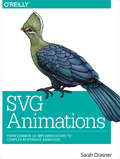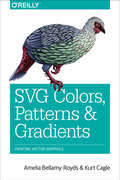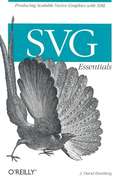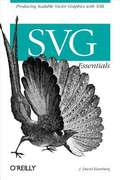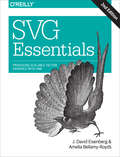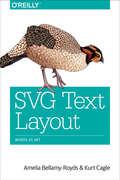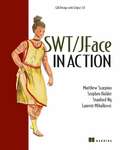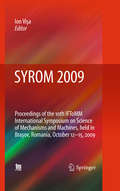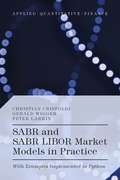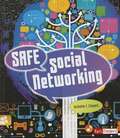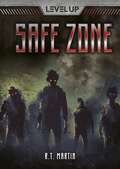- Table View
- List View
SVA: The Power of Assertions in SystemVerilog
by Surrendra Dudani Dmitry Korchemny Eduard Cerny John HavlicekThis book is a comprehensive guide to assertion-based verification of hardware designs using System Verilog Assertions (SVA). It enables readers to minimize the cost of verification by using assertion-based techniques in simulation testing, coverage collection and formal analysis. The book provides detailed descriptions of all the language features of SVA, accompanied by step-by-step examples of how to employ them to construct powerful and reusable sets of properties. The book also shows how SVA fits into the broader System Verilog language, demonstrating the ways that assertions can interact with other System Verilog components. The reader new to hardware verification will benefit from general material describing the nature of design models and behaviors, how they are exercised, and the different roles that assertions play. This second edition covers the features introduced by the recent IEEE 1800-2012. System Verilog standard, explaining in detail the new and enhanced assertion constructs. The book makes SVA usable and accessible for hardware designers, verification engineers, formal verification specialists and EDA tool developers. With numerous exercises, ranging in depth and difficulty, the book is also suitable as a text for students.
SVG Animations: From Common UX Implementations to Complex Responsive Animation
by Sarah DrasnerSVG is extremely powerful, with its reduced HTTP requests and crispness on any display. It becomes increasingly more interesting as you explore its capabilities for responsive animation and performance boons. When you animate SVG, you must be aware of normal image traits like composition, color, implementation, and optimization. But when you animate, it increases the complexity of each of these factors exponentially.This practical book takes a deep dive into how you can to solve these problems with stability, performance, and creativity in mind.Learn how to make SVG cross-browser compatible, backwards compatible, optimized, and responsivePlan and debug animationMake a complex animation responsive, as many sites are responsiveProfile each animation technique in terms of performance so that you know what you're getting in to with each library or native technology
SVG Colors, Patterns & Gradients: Painting Vector Graphics
by Amelia Bellamy-Royds Kurt CagleAs a vector graphics format, SVG uses precisely-defined geometric shapes to build an image. But that doesn't mean that SVG graphics have to look like technical drawings. SVG graphics can be shaded, textured, built from partially-transparent overlapping layers, or even filled with photographic images.SVG Colors, Patterns, and Gradients takes an in-depth look at the different ways SVG text and shapes can be painted on the screen or page. You’ll start with an overview of how color is defined, including the various ways you can control the transparency of SVG content. You’ll then dive deep into the concept of an SVG paint server: gradients, patterns, and other complex graphical content that can be used to fill-in or outline other SVG shapes and text.
SVG Essentials
by J. David EisenbergScalable Vector Graphics -- or SVG -- is the new XML-based graphics standard from the W3C that will enable Web documents to be smaller, faster and more interactive. This insightful book takes you through the ins and outs of SVG, from the basics to more complicated features. Whether you're a graphic designer looking for new tools, or a programmer creating and managing graphics, this book provides a solid foundation.
SVG Essentials
by J. EisenbergScalable Vector Graphics -- or SVG -- is the new XML-based graphics standard from the W3C that will enable Web documents to be smaller, faster and more interactive. J. David Eisenberg's insightful book takes you through the ins and outs of SVG, beginning with basics needed to create simple line drawings and then moving through more complicated features like filters, transformations, and integration with Java, Perl, and XSLT. Unlike GIFs, JPEGs or PNGs (which are bitmapped), SVG images are both resolution- and device-independent, so that they can scale up or down to fit proportionally into any size display or any Internet device -- from PDAs to large office monitors and high-resolution printers. Smaller than bitmapped files and faster to download, SVG images can be rendered with different CSS styles for each environment. They work well across a range of available bandwidths. SVG makes it possible for designers to escape the constant need to update graphics by hand or use custom code to generate bitmap images. And while SVG was created with the Web in mind, the language has a variety of other uses. SVG greatly simplifies tasks like: Creating web sites whose graphics reflect the content of the page, changing automatically if the content changes Generating graphs and charts from information stored in a wide variety of sources Exchanging detailed drawings, from architectural plans to CAD layouts to project management diagrams Creating diagrams that users can explore by zooming in and panning around Generating bitmap images for use in older browsers using simple automatable templates Managing graphics that support multiple languages or translations Creating complex animation By focusing sharply on the markup at the foundation of SVG, SVG Essentials gives you a solid base on which to create your own custom tools. Explanations of key technical tools -- like XML, matrix math, and scripting -- are included as appendices, along with a reference to the SVG vocabulary. Whether you're a graphic designer in search of new tools or a programmer dealing with the complex task of creating and managing graphics, SVG Essentials provides you with the means to take advantage of SVG.
SVG Essentials: Producing Scalable Vector Graphics with XML
by J. David Eisenberg Amelia Bellamy-RoydsLearn the essentials of Scalable Vector Graphics, the mark-up language used by most vector drawing programs and interactive web graphics tools. SVG Essentials takes you through SVG’s capabilities, beginning with simple line drawings and moving through complicated features such as filters, transformations, gradients, and patterns.This thoroughly updated edition includes expanded coverage of animation, interactive graphics, and scripting SVG. Interactive examples online make it easy for you to experiment with SVG features in your web browser. Geared toward experienced designers, this book also includes appendices that explain basic concepts such as XML markup and CSS styling, so even if you have no web design experience, you can start learning SVG.Create and style graphics to match your web design in a way that looks great when printed or displayed on high-resolution screensMake your charts and decorative headings accessible to search engines and assistive technologiesAdd artistic effects to your graphics, text, and photographs using SVG masks, filters, and transformationsAnimate graphics with SVG markup, or add interactivity with CSS and JavaScriptCreate SVG from existing vector data or XML data, using programming languages and XSLT
SVG Text Layout: Words as Art
by Amelia Bellamy-Royds Kurt CagleScalable Vector Graphics (SVG) is an image format, so text isn’t the first thing you might think of when considering its uses. But one of SVG’s key features is its ability to encode text in a machine-readable form. This book takes a deep dive into the use of text within SVG to explore the creative possibilities as well as the potential pitfalls. You’ll start with SVG’s text basics, and then learn methods for using SVG to generate complex layouts.If you’re an intermediate SVG developer familiar with CSS-styled HTML text, you’re ready to get going. This book covers:The SVG text and tspan elements, and basic attributes for positioning simple text labels within a graphicSVG’s fill and stroke properties for controlling text’s visual appearanceComplex text layouts, using formatted poetry as examplesFeatures to set the position and orientation of individual text charactersMultidirectional text, including right-to-left horizontal text and vertical textCurved or complex text layouts with the textPath elementFont options for your SVG, including web fonts, and their impact on text layout
SWT/JFace in Action: GUI Design with Eclipse 3.0
by Matthew Scarpino Laurent Mihalkovic Stanford Ng Stephen HolderCovering Eclipse's new capability for building graphical user interfaces with version 3.0, the Standard Widget Toolkit (SWT) and JFace, this guide demonstrates how these award-winning tools have received broad support for creating desktop applications. Theory and practical examples reveal how to build GUIs that combine the look and feel of native interfaces with the platform independence of Java. This guide also shows how SWT makes use of the widgets provided by the operating system and describes how these components can be associated with events, containers, and graphics. With this knowledge, programmers can build fully featured user interfaces that communicate directly with the underlying platform. JFace's ability to simplify and organize the process of GUI design is then demonstrated, enabling developers to modify and adapt components, and separate their information from their appearance.
SWT: A Developer's Notebook
by Tim HattonIn typical Developer's Notebook style, you'll learn how to take SWT out for a spin, make it work for you,and turn it upside down, all without wasted words or space. Each lab in this notebook details a specific task; you can read from the first page to the last, look up just what you need to know, and even squeeze this book into your laptop bag as a quick reference when you forget how to create a multi-tabbed view.
SYROM 2009
by Ion VisaSYROM conferences have been organized since 1973 by the Romanian branch of the International Federation for the Promotion of Mechanisms and Machine Science IFToMM, Year by year the event grew in quality. Now in its 10th edition, international visibility and recognition among the researchers active in the mechanisms science field has been achieved. SYROM 2009 brought together researchers and academic staff from the field of mechanisms and machine science from all over the world and served as a forum for presenting the achievements and most recent results in research and education. Topics treated include conceptual design, kinematics and dynamics, modeling and simulation, synthesis and optimization, command and control, current trends in education in this field, applications in high-tech products. The papers presented at this conference were subjected to a peer-review process to ensure the quality of the paper, the engineering significance, the soundness of results and the originality of the paper. The accepted papers fulfill these criteria and make the proceedings unique among the publications of this type.
Sabr and Sabr LIBOR Market Models in Practice: With Examples Implemented in Python (Applied Quantitative Finance)
by Peter Larkin Christian Crispoldi GéraldwiggerSabr and Sabr LIBOR Market Models in Practice.
Sachkunde im Bewachungsgewerbe (IHK) - Übungsbuch: 250 Fragen mit Antworten und 10 Übungsfälle mit Lösungen
by Robert SchwarzDieses Übungsbuch ergänzt das gleichnamige Lehrbuch. Es schließt die Lücke zwischen dem Unterrichts- und Lernstoff und der Vorbereitung auf die Prüfung. Mit Hilfe der Fragen und Antworten können Lernende den wichtigen Prüfungsstoff strukturiert wiederholen, den eigenen Lernfortschritt kontrollieren und sich gründlich auf die Prüfung vorbereiten. Zehn Übungsfälle mit ausführlichen Lösungen stellen Zusammenhänge her und vertiefen das Gelernte. Die aktualisierte 3. Auflage wurde gründlich durchgesehen.
Sachkunde im Bewachungsgewerbe (IHK) - Übungsbuch: 250 Fragen mit Antworten und 10 Übungsfälle mit Lösungen
by Robert SchwarzDieses Übungsbuch ergänzt das gleichnamige Lehrbuch. Es schließt die Lücke zwischen dem Unterrichts- und Lernstoff und der Vorbereitung auf die Prüfung. Mit Hilfe der Fragen und Antworten können Lernende den wichtigen Prüfungsstoff strukturiert wiederholen, den eigenen Lernfortschritt kontrollieren und sich gründlich auf die Prüfung vorbereiten. Zehn Übungsfälle mit ausführlichen Lösungen stellen Zusammenhänge her und vertiefen das Gelernte. Die aktuelle 4. Auflage wurde sorgfältig durchgesehen.
Sachkunde im Bewachungsgewerbe (IHK) - Übungsbuch: 250 Fragen mit Antworten und 10 Übungsfälle mit Lösungen
by Robert SchwarzDieses Übungsbuch ergänzt das gleichnamige Lehrbuch. Es schließt die Lücke zwischen dem Unterrichts- und Lernstoff und der Vorbereitung auf die Prüfung. Mit Hilfe der Fragen und Antworten können Lernende den wichtigen Prüfungsstoff strukturiert wiederholen, den eigenen Lernfortschritt kontrollieren und sich gründlich auf die Prüfung vorbereiten. Zehn Übungsfälle mit ausführlichen Lösungen stellen Zusammenhänge her und vertiefen das Gelernte. Die überarbeitete 5. Auflage entspricht dem aktuellen Rahmenstoffplan vom Mai 2021.
Sachkunde im Bewachungsgewerbe (IHK): Lehrbuch für Prüfung und Praxis
by Robert SchwarzDieses Lehrbuch behandelt systematisch alle Fachgebiete der IHK-Sachkundeprüfung nach dem aktuellen Rahmenstoffplan. Besonderen Wert hat der Autor dabei auf den oft als schwierig empfundenen Rechtsteil gelegt: Zahlreiche Abbildungen und Beispiele veranschaulichen die Gesetzestexte und ihre Bedeutung für die Praxis, erleichtern das Stoffverständnis und das Lernen. Übersichtlich und verständlich erläutert das Buch die Grundprinzipien der Rechtsordnung der Bundesrepublik Deutschland und deren Anwendung, wichtige Fachbegriffe und die Stellung der privaten Sicherheit. So bietet das Werk die optimale Prüfungsvorbereitung - Schritt für Schritt. Die korrigierte und aktualisierte 4. Auflage wurde dem aktuellen Rahmenstoffplan im Frühjahr 2020 angepasst, insbesondere bezüglich der Verordnung über das Bewachungsgewerbe (BewachV).
Sachkunde im Bewachungsgewerbe (IHK): Lehrbuch für Prüfung und Praxis
by Robert SchwarzDieses Lehrbuch behandelt systematisch alle Fachgebiete der IHK-Sachkundeprüfung nach dem aktuellen Rahmenstoffplan. Besonderen Wert hat der Autor dabei auf den oft als schwierig empfundenen Rechtsteil gelegt: Zahlreiche Abbildungen und Beispiele veranschaulichen die Gesetzestexte und ihre Bedeutung für die Praxis, erleichtern das Stoffverständnis und das Lernen. Übersichtlich und verständlich erläutert das Buch die Grundprinzipien der Rechtsordnung der Bundesrepublik Deutschland und deren Anwendung, wichtige Fachbegriffe und die Stellung der privaten Sicherheit. So bietet das Werk die optimale Prüfungsvorbereitung – Schritt für Schritt. Die gründlich durchgesehene und verbesserte 5. Auflage entspricht dem aktuellen Rahmenstoffplan 2020/2021 und berücksichtigt auch die Verordnung über das Bewachungsgewerbe (BewachV).
Sachkunde im Bewachungsgewerbe (IHK): Lehrbuch für Prüfung und Praxis
by Robert SchwarzDieses Lehrbuch behandelt systematisch alle Fachgebiete der IHK-Sachkundeprüfung nach dem aktuellen Rahmenstoffplan. Besonderen Wert hat der Autor dabei auf den oft als schwierig empfundenen Rechtsteil gelegt: Zahlreiche Abbildungen und Beispiele veranschaulichen die Gesetzestexte und ihre Bedeutung für die Praxis, erleichtern das Stoffverständnis und das Lernen. Übersichtlich und verständlich erläutert das Buch die Grundprinzipien der Rechtsordnung der Bundesrepublik Deutschland und deren Anwendung, wichtige Fachbegriffe und die Stellung der privaten Sicherheit. So bietet das Werk die optimale Prüfungsvorbereitung – Schritt für Schritt. Die überarbdeitete 6. Auflage entspricht dem aktuellen Rahmenstoffplan der DIHK vom Mai 2021.
Sadiq and the Gamers (Sadiq)
by Siman NuuraliSadiq and his friends are starting a video game club at school. They have fun playing together and planning a tournament for the whole school to participate in. But when their club needs a service project, the club members are stumped. How can they help people with video games? Then, during a visit to a retirement home called Harmony House with his mother, Sadiq meets a man named Mr. Soto who could use some cheering up. Sadiq begins to form an idea. Could gaming be a way to help the residents at Harmony House?
Safe Autonomy with Control Barrier Functions: Theory and Applications (Synthesis Lectures on Computer Science)
by Wei Xiao Calin Belta Christos G. CassandrasThis book presents the concept of Control Barrier Function (CBF), which captures the evolution of safety requirements during the execution of a system and can be used to enforce safety. Safety is formalized using an emerging state-of-the-art approach based on CBFs, and many illustrative examples from autonomous driving, traffic control, and robot control are provided. Safety is central to autonomous systems since they are intended to operate with minimal or no human supervision, and a single failure could result in catastrophic results. The authors discuss how safety can be guaranteed via both theoretical and application perspectives. This presented method is computationally efficient and can be easily implemented in real-time systems that require high-frequency reactive control. In addition, the CBF approach can easily deal with nonlinear models and complex constraints used in a wide spectrum of applications, including autonomous driving, robotics, and traffic control. With the proliferation of autonomous systems, such as self-driving cars, mobile robots, and unmanned air vehicles, safety plays a crucial role in ensuring their widespread adoption. This book considers the integration of safety guarantees into the operation of such systems including typical safety requirements that involve collision avoidance, technological system limitations, and bounds on real-time executions. Adaptive approaches for safety are also proposed for time-varying execution bounds and noisy dynamics.
Safe C++: How to avoid common mistakes
by Vladimir KushnirIt’s easy to make lots of programming mistakes in C++—in fact, any program over a few hundred lines is likely to contain bugs. With this book, you’ll learn about many common coding errors that C++ programmers produce, along with rules and strategies you can use to avoid them.Author Vladimir Kushnir shows you how to use his Safe C++ library, based in part on programming practices developed by the C++ community. You’ll not only find recipes for identifying errors during your program’s compilation, runtime, and testing phases, you’ll learn a comprehensive approach for making your C++ code safe and bug-free.Get recipes for handling ten different error types, including memory leaks and uninitialized variablesDiscover problems C++ inherited from C, like pointer arithmeticInsert temporary and permanent sanity checks to catch errors at runtimeApply bug prevention techniques, such as using separate classes for each data typePursue a testing strategy to hunt and fix one bug at a time—before your code goes into production
Safe Havens for Hate: The Challenge of Moderating Online Extremism
by Tamar MittsWhy efforts to moderate harmful content on social media fail to stop extremistsContent moderation on social media has become one of the most daunting challenges of our time. Nowhere is the need for action more urgent than in the fight against terrorism and extremism. Yet despite mass content takedowns, account suspensions, and mounting pressure on technology companies to do more, hate thrives online. Safe Havens for Hate looks at how content moderation shapes the tactics of harmful content producers on a wide range of social media platforms.Drawing on a wealth of original data on more than a hundred militant and hate organizations around the world, Tamar Mitts shows how differing moderation standards across platforms create safe havens that allow these actors to organize, launch campaigns, and mobilize supporters. She reveals how the structure of the information environment shapes the cross-platform activity of extremist organizations and movements such as the Islamic State, the Proud Boys, the Oath Keepers, and QAnon, and highlights the need to consider the online ecosystem, not just individual platforms, when developing strategies to combat extremism.Taking readers to the frontlines of the digital battleground where dangerous organizations operate, Safe Havens for Hate sheds critical light on how governments and technology companies grapple with the tension between censorship and free speech when faced with violence, hate, and extremism.
Safe Social Networking
by Frank W. Baker Heather E. SchwartzDescribes safe social networking usage and ways to avoid dangerous situations, such as identity theft, cyberbullying, or predators.
Safe Trajectory Planning for Maritime Surface Ships (Springer Series on Naval Architecture, Marine Engineering, Shipbuilding and Shipping #13)
by Agnieszka LazarowskaThis book offers a comprehensive review of collision avoidance techniques and safe trajectory planning for manned and unmanned ships, together with extensive information on how to develop and implement algorithms for applications in real-world settings. It describes the most relevant decision-support systems and guidance systems used in the control of marine craft, giving a special emphasis to autonomous vehicles, but also covering manned ones. Thanks to its good balance of theory and practice, and the inclusion of basic explanations of all essential concepts, this book fills an important gap in the literature of marine navigation, providing not only researchers and practitioners with a timely reference guide to safe trajectory planning, but also supporting students and newcomers to the field.
Safe Zone (Level Up)
by R. T. MartinNo_Idea has actually no idea how he wound up in the middle of a zombie apocalypse. It's not until he meets another player, named N3V3RDIE, that he learns he's been selected to test a virtual reality video game. And if they don't win the game, they'll be stuck inside the virtual world forever. Will No_Idea figure out the gameplay and make it to the game's safe zone in time, or will he end up trapped in a world filled with virtual zombies?
Safe and Secure Cyber-Physical Systems and Internet-of-Things Systems
by Marilyn Wolf Dimitrios SerpanosThis book provides the first comprehensive view of safe and secure CPS and IoT systems. The authors address in a unified manner both safety (physical safety of operating equipment and devices) and computer security (correct and sound information), which are traditionally separate topics, practiced by very different people. Offers readers a unified view of safety and security, from basic concepts through research challenges;Provides a detailed comparison of safety and security methodologies;Describes a comprehensive threat model including attacks, design errors, and faults;Identifies important commonalities and differences in safety and security engineering.

